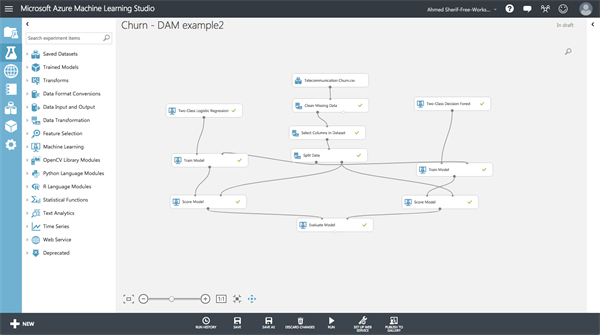
Machine Learning is changing the landscape of the modern world, spanning countless industries as people, businesses, and governments strive to progress and move forward in the 21st century. If you aren’t entrenched in the world of predictive analytics or data analysis, you might ask yourself, “what exactly is machine learning?” The answer is abundantly straightforward. Machine learning is a way of applying historical data to a problem and using a created model to successfully predict future behavior or trends.
Microsoft’s Azure Machine Learning streamlines this into a user-friendly cloud-based workbench for data science workflow, including the capability to author, evaluate, collaborate, and publish predictive models. One example of using Azure Machine Learning to produce valuable analytics is churn. Churn describes a rate of attrition in a area, for example the number customers, subscribers, or even employees.
Azure Machine Learning enables users to easily create models that score data to produce meaningful insights. Azure ML has an inherent design like Visio or PowerPoint, so it is relatively easy to use this robust application. Azure ML allows the user to have manual control of all operations, supporting simple click and drag functionality, all the while sporting a user-friendly graphical interface to visualize each step within a workflow for building a model.
Unlike other ML tools, Azure ML does not limit the operator to classification and regression models, allowing for use of a variety of algorithms while building models. Additionally, Azure ML provides access to supervised model creation where the outcome is available as well as unsupervised learning where there is not a known outcome. For those users just getting started or performing more common analysis, Azure ML provides a set of templates available in the Cortana Intelligence Gallery that are prebuilt for reuse.
The Azure suite also makes collaboration within a team simplistic, providing the capability to invite others to your work space, allowing individuals to work in their browser with no downloads or installations. Within Azure ML, users can specify a team data science process. When publishing a model, the manipulations that other data scientists implement will come back to you for approval. Along with version control, AML also provides tools for implementing task lists, code review, data exploration, and modeling.
All of that sounds great, but how do we implement Azure ML to provide actual value? Let’s use that churn example I mentioned earlier. Let’s say your company wants to know which customers are most likely to stop buying their product. The goal is to identify the people who are leaving your service, and what factors are facilitating this churn out of a data-set of 7,000 records. Assuming the data is binary, classification provides an excellent model for this inquiry. Within Azure Machine Learning, it is easy to build a data model from scratch, in this case, most likely creating a logistic regression or random forest model. This platform allows you to immediately profile your data, allowing you to conceptualize what you are working with, while also allowing you to identify any possible gaps that may be present throughout said data. If this is the case, you can go in and clean this missing data from Azure ML. For instance, if you locate missing data, you can go into the cleaning mode option and replace the missing values with the overall mean or remove them entirely. This allows users to control any outliers that your data may have that may inaccurately affect your analysis. You can also split your data to train and test the model all from within Azure ML. Below is an example of a churn model in Azure ML.

When running your churn model, Azure ML allows you to look through various contributing factors in the data, assigning weights to different data-sets and allowing the operator to determine what factors are affecting the outcome of the data model. When you score your churn model, Azure ML will produce a summary that shows how well your model performed its predictions against the actual data in the model.
AML also provides the ability to conduct apples to apples comparisons, running multiple models to determine which is the most accurate. AML will also provide a breakdown of what level of accuracy each model has provided, and the user can further delve into the predictive statistics that each model provides.
From here, you can export your scored data-set for future use, whether that is for further visualization or deeper predictive analysis or continue to manipulate this data-set directly in Azure instead of exporting the data. Additionally, models can be published as web services and productionized, providing an opportunity for collaboration on the models that you have created.
Ultimately, Azure Machine Learning provides a superior predictive analytic capability for companies at an affordable price, offering flexibility and control from an operational standpoint to enable its users to provide quick and clear value to their targeted interests.
Interested in learning more about the machine learning capabilities of Microsoft Azure? Contact us today.




